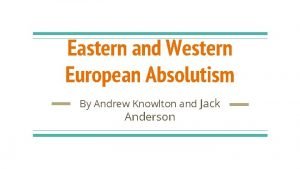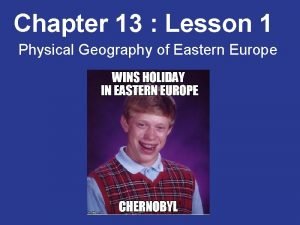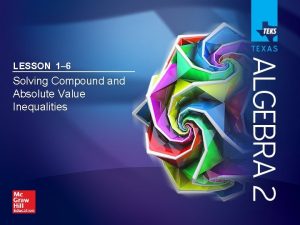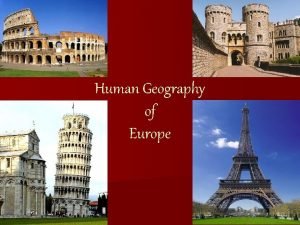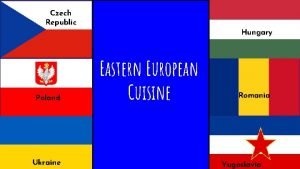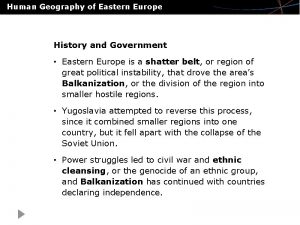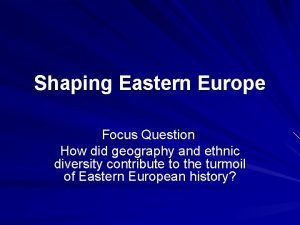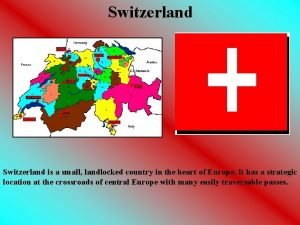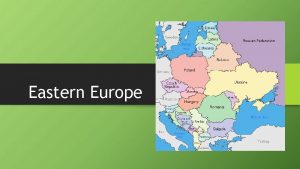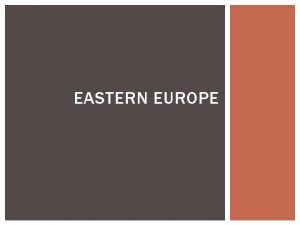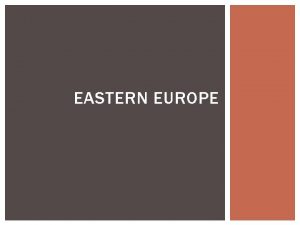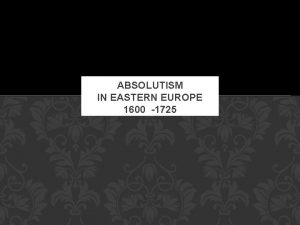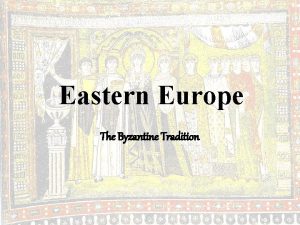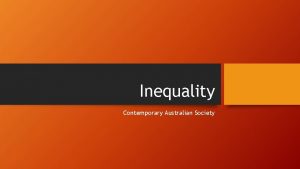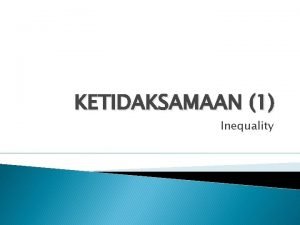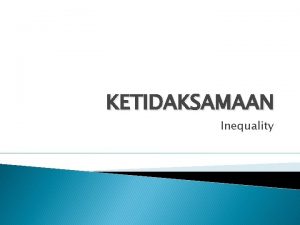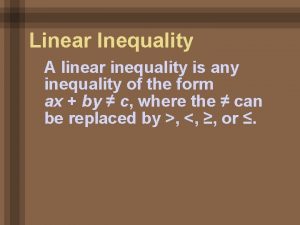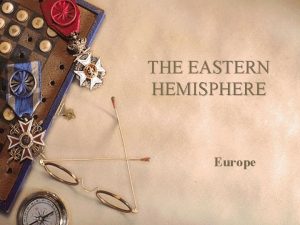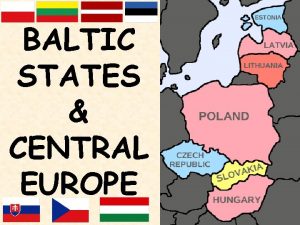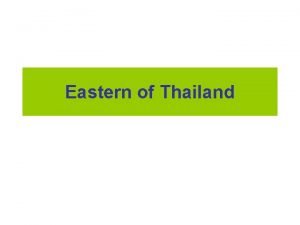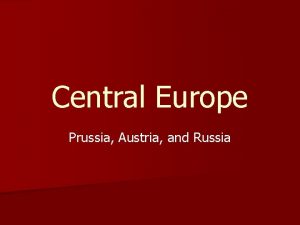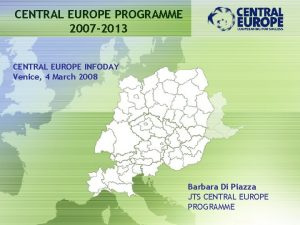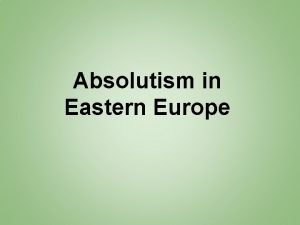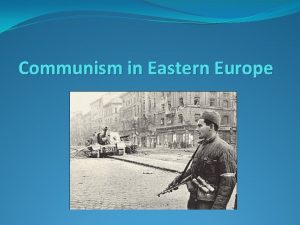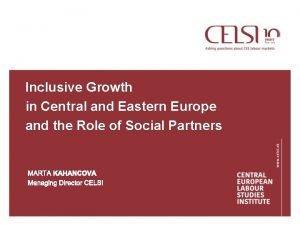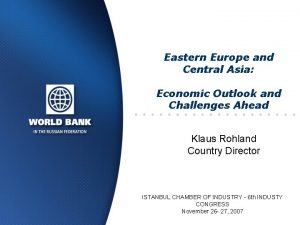The Roma in Central and Eastern Europe Inequality
































- Slides: 32

The Roma in Central and Eastern Europe - Inequality and Its Consequences Irina Tomescu-Dubrow Polish Academy of Sciences (PAN) and CONSIRT, OSU - PAN

Roma Presence in Europe – Theories of Origin Indian Origins of the Roma - initially proposed by Heinrich Grellman (1783, University of Goettingen); - is based on the similarities between Romani and languages spoken in the Indian subcontinent; - initial migrations passed through Persia (Iran), Armenia, Greece and the Slavic-speaking parts of the Balkans. For comprehensive review: Fraser, A. The Gypsies. Oxford: Blackwell Publishers, 1992. Cultural Diffusion Judith Okely, Willems, Leo Luccassen

Terminology and Measurement Issues Roma (Rom; Dom; Lom) – man; human being Gypsy - "Egyptian" Tsigan – "Atsigan“ - untouchable in the old Greek language Sinti Council of Europe: Roma and Travellers





Counting the Roma - Measurement Issues

Post-hoc operational defintions of Roma Representative National Sample - Respondents’ Identification (Self-identification) - Interviewers’ Identification (Hetero-identification) A priori operational defintions of Roma Pre-screened Roma Sample - Institutional Identification (Survey administrator; Experts; Interviewer) - Community Identification (Neighborhoods and Neighbors) Operational definitions of the Roma minority have consequences for collecting and analyzing (survey) data on the Roma

Roma’s Experience with Inequality in Post-communist Europe In sociological tradition, the main dimensions of social inequality are formal education, occupation, and income. 2006 UNDP report “At Risk: Roma and the Displaced in Southeast Europe. ” http: //hdr. undp. org/en/reports/regionalreports/europethecis/name, 3460, en. html Albania, Bosnia-Herzegovina, Bulgaria, Croatia, Kosovo, Macedonia, Montenegro, Romania, Serbia Roma Samples: from national Census data, using both post-hoc and a priori definition Non-Roma Samples: representative samples of non-Roma communities living in settlements with Roma communities of ‘average and above’ size.

Social Inequality Education I Literacy rates: Roma 73. 2% Majority 96. 4%

Social Inequality Education II

Social Inequality Occupation/Employment I

Social Inequality Occupation/Employment II

Informal sector: activities for which income was not reported for tax and social security purposes

Social Inequality Income

Political Inequality -the extent to which groups within society differ in influence over government decisions. Roma political organizations routinely divide btw. themselves the Romani vote – cannot achieve the 3 -5% threshold to make it into the parliament. Roma are under-represented in national office

III. Drives of Inequality Institutional Discrimination Sate Policies toward the Roma: Containment; Extermination; Assimilation Biased reaction of the judiciary, the police & the media to crimes committed by the Roma Institutional Failure Insufficient resources for effective protection of poor Roma during the post-communist transition process Weak de facto protection through international social actors, especially EU agencies Cultural barriers Reliance on informal, within-community (within clan) power structures, that are often in conflict with the formal authorities Traditional gender roles Wealth-poverty cleavages within the Roma: marginalization of the poor Roma by those ‘who made it’ Small, fragmented Roma elite







IV. Consequences of Inequality Poverty The UNDP report uses household consumption, measured in expenditure terms, as a proxy for welfare in assessing poverty rates. To allow for regional comparability: - threshold of PPP $4. 30 in daily equivalized expenditures = absolute poverty line; - threshold of PPP $2. 15 for ‘extreme’ poverty


Ethnic Tensions Public protests as Political Means Romania 2006: The riots in Ferentari neighborhood Electricity provider cut the electricity of some blocks, due to energy theft (estimated at $639, 000 per month) and consumer debts ($595, 000) Protests were sparked by the death of four Roma children, who asphyxiated in the basement of an apartment block, as a result of a fire caused by candles Around 200 inhabitants protested violently against their situation, by torching tires, blocking traffic in the area, etc.



Consistently high levels of ethnic tensions between Roma and non-Roma, both in CEE and Western Europe Romania: since 1990, over 30 conflicts in which non-Roma have injured and/or chased the Roma from their homes, which in many instances they set on fire Often, clashes develop in retaliation for a local incident (Hadareni case; killings in Hungary), as non-Roma attack the community as a whole

Conclusions and Discussion Inequality permeates all aspects of Roma’s everyday life (e. g. health; migration; segregation) Reciprocal relationship between correlates of inequality. Low educational achievement as both outcome and perpetuator of poverty and inequality Romani mobilization as agent of change

Bibliography and Resources Barany, Zoltan. 2002. The East European Gypsies: Regime Change, Marginality, and Ethnopolitics New York: Cambridge University Press Emigh, Rebecca J and Ivan Szelenyi. Ed. 2001. “Poverty, Ethnicity and Gender in Eastern Europe during the Market Transition” Westport: Praeger Publishers Cristina Rat, 2005. ““Romanian Roma, State Transfers, and Poverty” International Journal of Sociology p. 85 -116. Poverty, Ethnicity and Gender in Eastern Europe, 2000 (PEGEE), principal investigator Ivan Szelenyi. 2006 UNDP report “At Risk: Roma and the Displaced in Southeast Europe. ” http: //hdr. undp. org/en/reports/regionalreports/europethecis/name, 3460, en. html www. coe. int/education/roma http: //photo. romadecade. org/index. php? content=6&picture_id=852&category=1&age=1215&sort=countryname&view=20&page=5
 Differences between western and eastern europe
Differences between western and eastern europe How do mountains and plains define eastern europe?
How do mountains and plains define eastern europe? 1-6 solving compound and absolute value inequalities
1-6 solving compound and absolute value inequalities Ussr control over eastern europe igcse
Ussr control over eastern europe igcse What is considered eastern europe
What is considered eastern europe Is poland considered eastern europe
Is poland considered eastern europe Eastern europe landforms
Eastern europe landforms Shatter belt definition ap human geography
Shatter belt definition ap human geography Offshoring eastern europe
Offshoring eastern europe How did its rivers affect eastern europe
How did its rivers affect eastern europe Italian cdm
Italian cdm Switzerland landlocked country
Switzerland landlocked country Hình ảnh bộ gõ cơ thể búng tay
Hình ảnh bộ gõ cơ thể búng tay Slidetodoc
Slidetodoc Bổ thể
Bổ thể Tỉ lệ cơ thể trẻ em
Tỉ lệ cơ thể trẻ em Voi kéo gỗ như thế nào
Voi kéo gỗ như thế nào Tư thế worms-breton
Tư thế worms-breton Bài hát chúa yêu trần thế alleluia
Bài hát chúa yêu trần thế alleluia Môn thể thao bắt đầu bằng chữ f
Môn thể thao bắt đầu bằng chữ f Thế nào là hệ số cao nhất
Thế nào là hệ số cao nhất Các châu lục và đại dương trên thế giới
Các châu lục và đại dương trên thế giới Cong thức tính động năng
Cong thức tính động năng Trời xanh đây là của chúng ta thể thơ
Trời xanh đây là của chúng ta thể thơ Mật thư anh em như thể tay chân
Mật thư anh em như thể tay chân Làm thế nào để 102-1=99
Làm thế nào để 102-1=99 Phản ứng thế ankan
Phản ứng thế ankan Các châu lục và đại dương trên thế giới
Các châu lục và đại dương trên thế giới Thơ thất ngôn tứ tuyệt đường luật
Thơ thất ngôn tứ tuyệt đường luật Quá trình desamine hóa có thể tạo ra
Quá trình desamine hóa có thể tạo ra Một số thể thơ truyền thống
Một số thể thơ truyền thống Cái miệng xinh xinh thế chỉ nói điều hay thôi
Cái miệng xinh xinh thế chỉ nói điều hay thôi Vẽ hình chiếu vuông góc của vật thể sau
Vẽ hình chiếu vuông góc của vật thể sau
